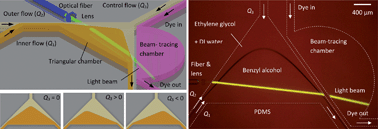This paper presents a tunable optofluidic prism based on the configuration of two laminar flow streams with different refractive indices in a triangular chamber. The chambers with 70° and 90° apex angles are designed based on simulation results, which provide the optimum working range and avoid recirculating flows in the chambers. In addition, a hydrodynamic model has been developed to predict the tuning of the prisms by the variation in the flow rates. Prisms with different refractive indices are realized using benzyl alcohol and deionized (DI) water as the inner liquids, respectively. The mixture of ethylene glycol and DI water with an effective refractive index matched to that of the microchannel is used as the outer liquid. The apex angle of the prism is tuned from 75° to 135° by adjusting the ratio of the two flow rates. Subsequently, the deviation angle of the output light beam is tuned from −13.5° to 22°. One of the new features of this optofluidic prism is its capability to transform from a symmetric to an asymmetric prism with the assistance of a third flow. Two optical behaviours have been performed using the optofluidic prism. First, parallel light beam scanning is achieved with a constant deviation angle of 10° and a tuning range of 60 μm using the asymmetric prism. The detected output light intensity is increased by 65.7%. Second, light dispersion is experimentally demonstrated using 488-nm and 633-nm laser beams. The two laser beams become distinguishable with a deviation angle difference of 2.5° when the apex angle of the prism reaches 116°.

You have access to this article
 Please wait while we load your content...
Something went wrong. Try again?
Please wait while we load your content...
Something went wrong. Try again?


 Please wait while we load your content...
Please wait while we load your content...